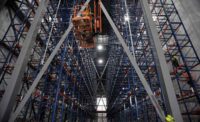As projects have grown larger and increasingly more complex, so has the size of their accompanying design documents. To operate more efficiently, many contractors are fully integrating the use of mobile devices in the field, allowing them to digitally access what would normally be reams of blueprints.
"Traditionally, if a superintendent is asked a question that he doesn't readily have the answer to, he has to go back to the site office and search the paper plans. On a massive jobsite, that could take hours. With an iPad on hand, that process is reduced to minutes. We are seeing an average savings of two hours per day for each superintendent," says Goodrich.
Contractors are jumping into the technology arena, investing in software, personnel and their own programming to streamline the construction process. Sellen Construction has created a new chief information officer position. The firm plans "a major investment in technologies that will increase our efficiencies in preconstruction and design, field operations, project management systems, and construction means and methods," says Bob McCleskey, CEO.
Many contractors are developing their own apps to address both general and specific worksite needs. For example, Hill & Wilkinson General Contractors developed its own field application, the so-called Superintendent's Work Center, which is available to all field personnel on smartphones and iPads, says Paul Driscoll, CEO.
Bechtel has established innovation centers in Houston and London to explore where technology can improve efficiency. "Right now, 3- and 4-D designs are common. We believe these innovation centers will push the limits of virtual project delivery and drive improvements in our integrated global EPC delivery model," says Bechtel.
Holding the Line on Prices
Despite a growing market, materials prices have not seen a major surge. "We have not seen much change in large commodity costs," says Whitney of Adolfson & Peterson Construction. However, he says there have been spot shortages and delivery delays in some of the specialty products the company uses.
There is some expansion and contraction in the marketplace regarding material pricing. "For example, in February, we received a notification from a major steel producer in the U.S. stating that some of their lighter shapes were being reduced in cost per ton," says Stephen Gray, CEO of Gray Construction. According to the notice, producers in other countries are trying to break into the U.S. market, and domestic mills are reducing prices to stay competitive, he says.
Contractors have been streamlining their processes to become more efficient, but so have materials and equipment suppliers. "Just-in-time [JIT] manufacturing practices, accompanied by JIT staffing, creates a delay in receipt of materials as demand for production has increased," says Kirk Warden, senior vice president at Clayco. He says this JIT approach affects the availability of everything from steel to toilet partitions. "No one is truly stocking product from manufacturing to distribution to the end user, creating a ripple effect for all involved in the supply chain."






